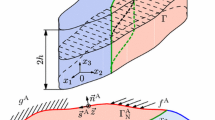Abstract
In this paper, discrete probabilistic models of interfaces are elaborated, focusing on the description of the damage and adhesion phenomena between two solid–solid interfaces. A discrete approach to damage is elaborated, adopting as a starting point the Daniels model of a set of interconnected springs endowed with a probabilistic rupture threshold. Brittle (elastic) and ductile (viscoelastic) behaviours of the bundle are successively envisaged. The consideration of a progressive degradation of the bonds between two surfaces in contact as a representation of damage leads to a limit Scott–Blair-type constitutive law with a fractional derivative. The inverse situation of the adhesive contact between two solids is analysed in the same vein.
Similar content being viewed by others
References
Weibull, W.: Proc Ing Vetenskapsakad Akad (1939), 153, p 151
Jeulin, D.: Fracture statistics models and crack propagation in random media. In: Ostoja-Starzewski, M., Jasiuk, I. (eds) Proceedings of the symposium on micromechanics of random media. Appl Mech Rev 47(1), Part 2, 141–150 (1994)
Daniels, H.E.: The statistical theory of the strength of bundles of threads. Proc R Soc A183, 405–435 (1945)
Kittl, P., Diaz, G.: Weibull's fracture statistics, or probabilistic strength of materials: state of the art. Res Mech 24, 99–207 (1998)
Sutherland, L.S., Guedes Soares, C.: Review of probabilistic models of the strength of composite materials. Reliabil Eng Syst Safe 56, 183–196 (1997)
Phoenix, S.L.: Probabilistic concepts in modelling the tensile behavior of fiber bundles and unidirectional fiber/matrix composites. In: Proceedings of the 3rd conference on composite materials: testing and design. Special technical publication, ASTM 546, 30 (1974)
Bullock, R.E.: Strength ratios of composite materials in flexure and in tension. J Compos Mater 8, 200–206 (1974)
Delaplace, A., Roux, S., Pijaudier-Cabot, G.: Damage cascade in a softening interface. Int J Solids Struct 36, 1403–1426 (1999)
Hemmer, P.C., Hansen, A.: The distribution of simultaneous fiber failures in fiber bundles. J Appl Mech 59, 909–914 (1992)
Corless, R.M., Gonnet, G.H., Hare, D.E.G., Jeffrey, D.J., Knuth, D.E.: On the Lambert W function. Maple's Share Library
Oustaloup, A.: La dérivation non-entière. Théorie, synthèse et applications, p 178. Hermès, Paris (1995)
Scott Blair, G.W., Caffynb J.E.: An application of the theory of quasi-properties to the treatment of anomalous strain-stess relations. Philos Mag 40, 80–94 (1949)
Podlubny, I.: Fractional differential equations, p 16. Academic, San Diego (1999)
Landmann, U., Luedtke, W.D., Ringer, E.M.: Wear 153, 3–15 (1992) [GC4]
Derks, D., Lindner, A., Creton, C., Bonn, D.: Cohesive failure of thin layers of soft model adhesives under tension. J Appl Phys 93(3), 1557–1566 (2003)
Creton, C., Hooker, J., Shull, K.R.: Bulk and interfacial contributions to the debonding mechanisms of soft adhesives: extension to large strains. Langmuir 17(16), 4948–4954 (2001)
Author information
Authors and Affiliations
Corresponding author
Rights and permissions
About this article
Cite this article
Haussy, B., Ganghoffer, J. Atomistic mechanisms of adhesive contact formation and interfacial processes. Arch Appl Mech 75, 338–354 (2006). https://doi.org/10.1007/s00419-005-0421-6
Received:
Accepted:
Published:
Issue Date:
DOI: https://doi.org/10.1007/s00419-005-0421-6




